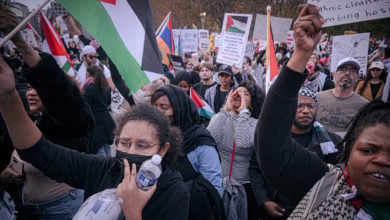Despite the ongoing wars in Iraq and Afghanistan, the U.S. military has opened yet another front in the so-called “War on Terror,” this time in Yemen.
 Independence protests in southern Yemen have been repeatedly attacked by government forces. |
The CIA began sending operatives to Yemen a year ago. Simultaneously, special-operations commandos began training Yemeni security forces. Separate secret visits to the country by U.S. regional commander Gen. David H. Petraeus and Obama administration advisor John O. Brennan began late this summer.
The Pentagon has already sent approximately $70 million in military aid this year to Yemen. (BBC News, Dec. 24, 2009) Future plans include spending an additional $70 million in military aid over the next 18 months.
Referring to the U.S. “War on Terror,” Connecticut Sen. Joseph I. Lieberman said, “Yemen now becomes one of the centers of that fight. … We have a growing presence there, and we have to, of Special Operations, Green Berets, intelligence.” (NY Times, Dec. 27, 2009)
With U.S. backing, Britain has called for a Jan. 28 international meeting to “combat terrorism” in Yemen.
Most recently, the United States aided the Yemeni government in two attacks on its own population.
On Dec. 24, Yemeni government forces attacked and killed as many as 34 people. Yemen’s deputy defense minister, Rashad al-Alaimy, said the strikes were carried out “using intelligence aid from Saudi Arabia and the U.S.” (The Guardian, Dec. 24, 2009) Foreign Minister Abu Bakr al-Qirbi said the United States provided both military hardware and intelligence information, which was “the most important element” in the assault. (NY Times, Dec. 27, 2009)
On Dec. 17, U.S. naval warships fired missiles into the north of the country, while Yemeni ground and air forces attacked the southern province of Abyan. One U.S. official said President Barack Obama personally ordered the U.S. missile strikes. (NBC News, Dec. 18, 2009)
Both Pentagon and Yemeni government sources cite the targeting of “al-Qaeda militants” as justification for the operations. Eyewitness testimony, however, contradicts those claims. Witnesses present said the victims were mostly civilians, including women and children, and estimated the number killed at more than 60 in the heaviest strike.
Local human rights activist Abbas al-Assal said 64 people were killed, including 23 children and 17 women. (NBC News, Dec. 18, 2009)
In addition, the U.S. client state of Saudi Arabia launched air and artillery attacks on Yemeni villages on Nov. 5 and Nov. 27. Battles between rebel forces and Yemen’s military occurred a day later.
The recent upsurge of violence is neither arbitrary nor without historical precedence. Yemen is one of the poorest countries in the Arab world, with nearly half its population of 24 million living in poverty. (BBC News, Dec. 24, 2009) The country is currently experiencing two separate conflicts; one in the north and one in the south.
According to U.N. agencies, the current conflict has resulted in a major humanitarian crisis. An estimated 175,000 Yemenis have been displaced, while the central government has been charged with major human rights violations.
Roots of the conflict
In the north, the Houthis rebels are members of the Zaydi branch of Shi’ite Islam. The majority of the population in the region identify with Zaydism, which is only found in Yemen.
The north was ruled by a Zaydi feudal theocracy until 1962, when a republican revolution overthrew the former ruling class and implemented capitalist development into the impoverished and underdeveloped nation.
In the aftermath of the revolution, an eight-year civil war broke out in which Britain, Saudi Arabia and the United States provided material aid to the former ruling classes, while Egypt sent troops with Soviet material aid to the revolutionary forces.
Meanwhile, in the south, the Peaceful Southern Mobilization Movement has been fighting for secession from the central government. Over the summer, Southern Movement demonstrators were brutally attacked by government forces.
Southern Yemen was colonized by Britain until 1967, when the occupiers were forced to withdraw by socialist revolutionaries who subsequently founded the People’s Democratic Republic of Yemen.
Northern and southern Yemen briefly united in 1990, but a civil war quickly developed when the southern forces attempted to secede in response to the domination of the pro-capitalist north. The southern forces were ultimately defeated and forced to reunite with the north in 1994.
Since that time, the Yemeni central government has pursued economic integration into the capitalist world, allying itself with U.S. interests in the region and collaborating with the “War on Terror.” The inevitable result has been an ever-increasing wealth gap between rich and poor.
U.S. imperialism’s greatest fear is that the Yemeni government could be greatly weakened or overthrown, resulting in large parts of the country becoming strongholds for forces opposed to U.S. domination of the region. If that were to happen, U.S.-led intervention would undoubtedly increase exponentially, causing still more death and destruction for the people of Yemen.
All anti-war forces must remain vigilant as the ongoing conflict develops. International solidarity with the Yemeni people is a vital necessity to combat increased foreign intervention by the United States or any of its many client states in the region.






